The ASUS Maximus VIII Extreme Review: The Other $500 Option
by Ian Cutress on April 7, 2016 9:00 AM EST- Posted in
- Motherboards
- Gaming
- Asus
- ROG
- Skylake
- Z170
- Thunderbolt 3
System Performance
Not all motherboards are created equal. On the face of it, they should all perform the same and differ only in the functionality they provide - however this is not the case. The obvious pointers are power consumption, but also the ability for the manufacturer to optimize USB speed, audio quality (based on audio codec), POST time and latency. This can come down to manufacturing process and prowess, so these are tested.
Power Consumption
Power consumption was tested on the system while in a single MSI GTX 770 Lightning GPU configuration with a wall meter connected to the OCZ 1250W power supply. This power supply is Gold rated, and as I am in the UK on a 230-240 V supply, leads to ~75% efficiency > 50W, and 90%+ efficiency at 250W, suitable for both idle and multi-GPU loading. This method of power reading allows us to compare the power management of the UEFI and the board to supply components with power under load, and includes typical PSU losses due to efficiency. These are the real world values that consumers may expect from a typical system (minus the monitor) using this motherboard.
While this method for power measurement may not be ideal, and you feel these numbers are not representative due to the high wattage power supply being used (we use the same PSU to remain consistent over a series of reviews, and the fact that some boards on our test bed get tested with three or four high powered GPUs), the important point to take away is the relationship between the numbers. These boards are all under the same conditions, and thus the differences between them should be easy to spot.
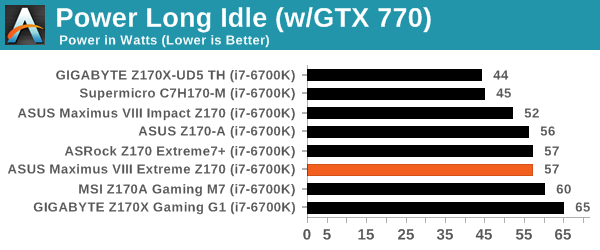
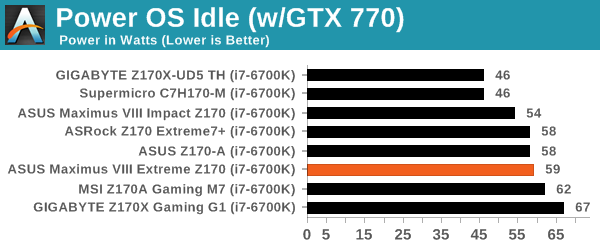
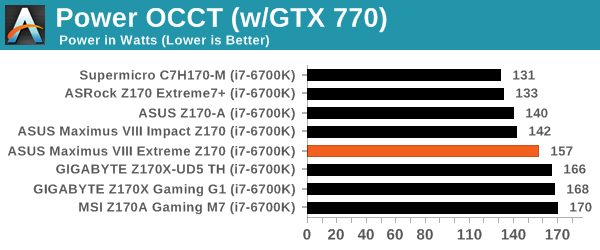
By the nature of being a large E-ATX motherboard with a number of extra controllers, one would expect the M8E to draw a fair bit of power, even under CPU load.
Non UEFI POST Time
Different motherboards have different POST sequences before an operating system is initialized. A lot of this is dependent on the board itself, and POST boot time is determined by the controllers on board (and the sequence of how those extras are organized). As part of our testing, we look at the POST Boot Time using a stopwatch. This is the time from pressing the ON button on the computer to when Windows 7 starts loading. (We discount Windows loading as it is highly variable given Windows specific features.)

Perhaps due to the emergence of Windows 10 and fast boot sequences, fewer motherboard companies are worrying about POST times, although they are now arguably the longest part of a start-up process, especially with the additional DDR4 training needed for validation. The Extreme is reasonably comfortable for its size at 16.50 seconds.
Rightmark Audio Analyzer 6.2.5
Rightmark:AA indicates how well the sound system is built and isolated from electrical interference (either internally or externally). For this test we connect the Line Out to the Line In using a short six inch 3.5mm to 3.5mm high-quality jack, turn the OS speaker volume to 100%, and run the Rightmark default test suite at 192 kHz, 24-bit. The OS is tuned to 192 kHz/24-bit input and output, and the Line-In volume is adjusted until we have the best RMAA value in the mini-pretest. We look specifically at the Dynamic Range of the audio codec used on board, as well as the Total Harmonic Distortion + Noise.

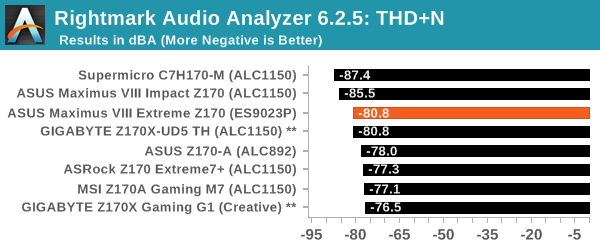
Audio performance from the Extreme gives it the highest SNR of any 100-series motherboard we’ve tested before.
USB Backup
For this benchmark, we transfer a set size of files from the SSD to the USB drive using DiskBench, which monitors the time taken to transfer. The files transferred are a 1.52 GB set of 2867 files across 320 folders – 95% of these files are small typical website files, and the rest (90% of the size) are small 30 second HD videos. In an update to pre-Z87 testing, we also run MaxCPU to load up one of the threads during the test which improves general performance up to 15% by causing all the internal pathways to run at full speed.
Due to the introduction of USB 3.1, as of June 2015 we are adjusting our test to use a dual mSATA USB 3.1 Type-C device which should be capable of saturating both USB 3.0 and USB 3.1 connections. We still use the same data set as before, but now use the new device. Results are shown as seconds taken to complete the data transfer.
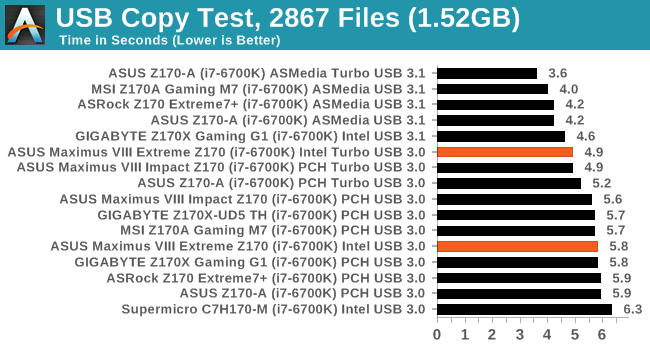
With ASUS’ USB Turbo, we get great performance in our USB 3.0 test. Unfortunately due to the nature of the Intel USB 3.1 controller, our testing software reports erroneous results stating that a transfer is complete faster than could be possible (and it’s a highly variable result). Interestingly we also had problems with the ASMedia controller, which behaved similarly.
DPC Latency
Deferred Procedure Call latency is a way in which Windows handles interrupt servicing. In order to wait for a processor to acknowledge the request, the system will queue all interrupt requests by priority. Critical interrupts will be handled as soon as possible, whereas lesser priority requests such as audio will be further down the line. If the audio device requires data, it will have to wait until the request is processed before the buffer is filled.
If the device drivers of higher priority components in a system are poorly implemented, this can cause delays in request scheduling and process time. This can lead to an empty audio buffer and characteristic audible pauses, pops and clicks. The DPC latency checker measures how much time is taken processing DPCs from driver invocation. The lower the value will result in better audio transfer at smaller buffer sizes. Results are measured in microseconds.

For better or worse, DPC Latency has been a wild ride on Z170. Some companies care deeply, others are not too fussed. Despite this, ASUS seems to have nailed down the formula for a great DPC Latency, and the Maximus VIII Extreme takes the crown from its smaller sibling in style.










70 Comments
View All Comments
willis936 - Thursday, April 7, 2016 - link
Well if you dump a grand on an extreme processor and not half a grand on a board you could get 8 cores that OC up to the same as the K series parts. Double the threaded performance but same single threaded performance.bill.rookard - Thursday, April 7, 2016 - link
I would have to agree, unless you are a hardcore overclocker. For those interested in hugely powerful graphics setups, this doesn't really cut it (dual GPU SLI only). For those who want huge storage arrays, this doesn't cut it either (half dozen SATA ports). Those interested in liquid nitrogen overclocks and need those last few mhz would find a use for it though...Chaitanya - Friday, April 8, 2016 - link
Normally I would have agreed, spending more than 250$ on Z/P series chipsets is useless and its better to go to X platform. But in this case there seems to be a good value in terms of bundle. That 10G Nic is worth the extra. There are no X99 boards below $500 mark that come with 10G nics.romrunning - Thursday, April 7, 2016 - link
"The cost of an i7-6700K plus a $500 motherboard comes in at $750 MSRP, "These prices seem really off. As of today, Amazon has the list price of the i7-6700k as $419.99. Simple math gets you to $919.99 with a $500 mobo, not $750.
Ian Cutress - Thursday, April 7, 2016 - link
Box price for 6700K is $350 (we've been covering the ups and downs of the price of the Skylake parts, see the link on the first page, where from time to time it is hitting MSRP), making it more $850, so I'm $100 out :) Updated. It's sill a big jump between the two, for sure.romrunning - Thursday, April 7, 2016 - link
So now I had to check Intel's "Recommended Customer Price" for the i7-5820k. Intel's site says box price is $396. So that + a $250 m/b would make the combo around $650, not $550. That would lower the different to more around $200. Still not insignificant, as that is the price of a decent m/b, but less than the previous cited difference.romrunning - Thursday, April 7, 2016 - link
Also, thanks for adding in the pricing info. It helps to give a measure of worth to the end-user to know the premium they are paying & what essentially you are buying over a more standard board.ImSpartacus - Friday, April 8, 2016 - link
I think he meant a 6600K.BrokenCrayons - Thursday, April 7, 2016 - link
Yes, $500 isn't exactly a princely sum, but I don't see value in spending that much on a single component of a computer. That's a week's play money for outings, shopping, and casual dining. Using it instead to buy a motherboard of all things only demonstrates to others in your social circles that you don't quite have your priorities sorted out. So thanks for the effort ASUS, but no thanks.Questor - Thursday, April 7, 2016 - link
Yes, blowing that much money on frivolous casual dining, outings and shopping is obviously a demonstration of financial brilliance! Priorities are as different among people as personal beliefs or political views. I won't pay the premium for this motherboard either, especially without dual M.2 slots to RAID NVMe SSDs. The OC Panel is unwanted bling to me as well, but I can see other people finding the M8E to be their "thing."